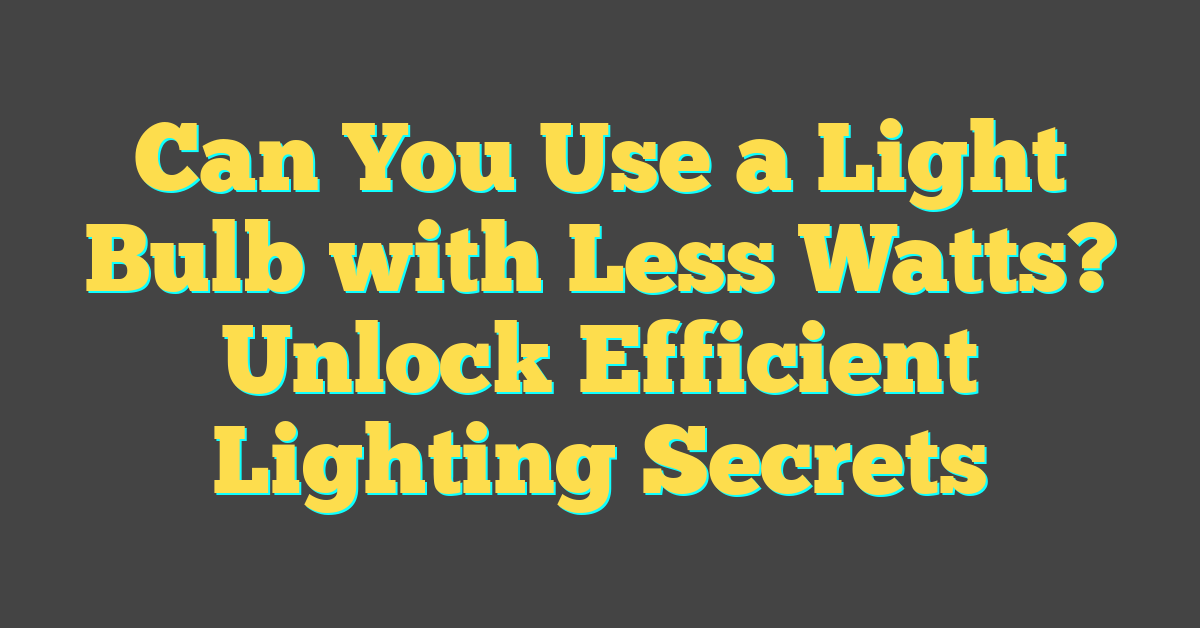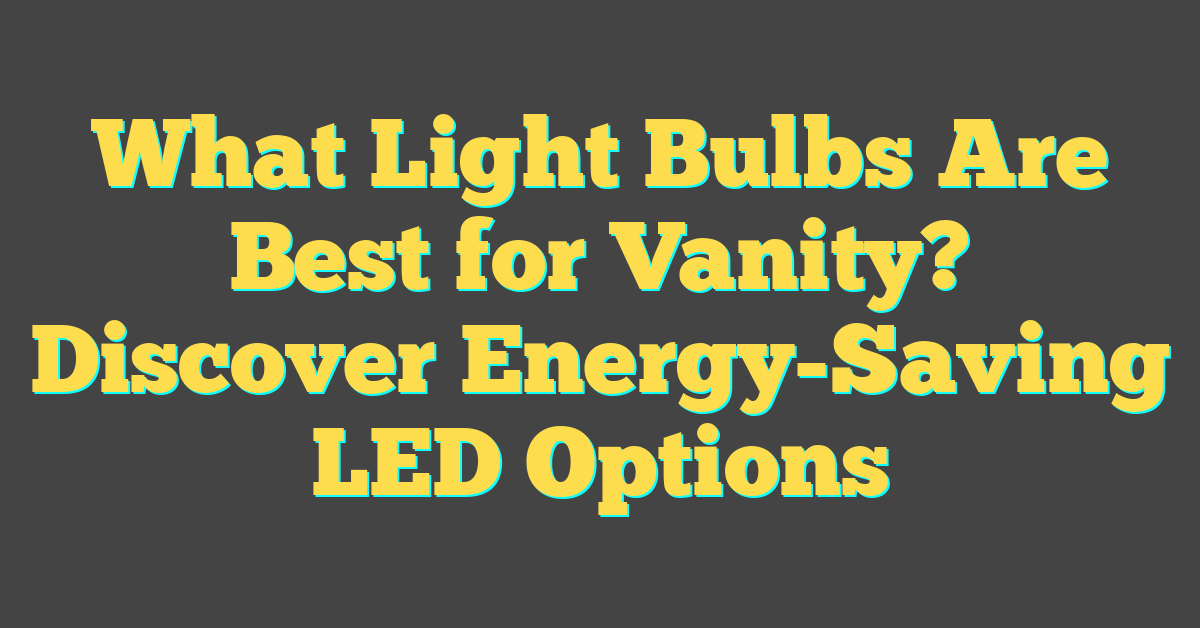Ever wondered if those regular lamps at home could double as a mini greenhouse? You’re not alone! Many plant lovers have asked if they can just pop a grow light bulb into a regular lamp. It’s a great question, especially if you’re looking to give your indoor plants a little boost without investing in specialized equipment.
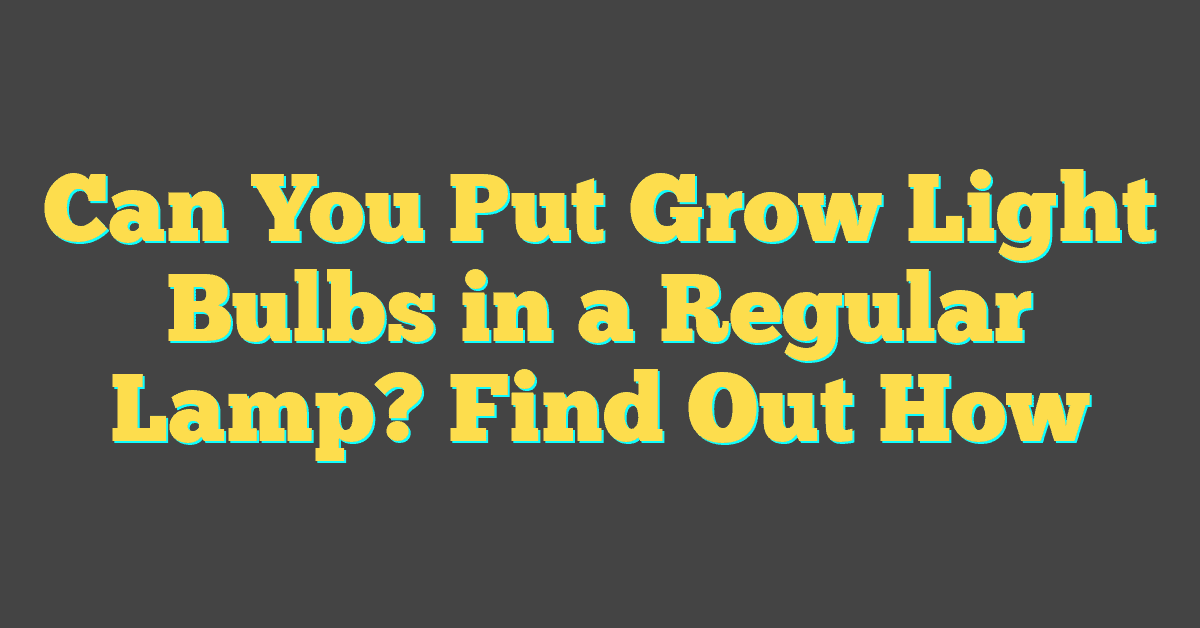
The good news is, it’s not as complicated as you might think. With the right bulb and a few considerations, you could be on your way to happier, healthier plants. So, let’s dive into the world of grow lights and regular lamps to see how they can work together for your indoor garden.
Can You Put Grow Light Bulbs in a Regular Lamp?
As a lover of all things lighting and DIY, you’ve probably wondered if your cozy corner lamp could double as a small beacon of hope for your indoor plants. The short answer is yes, you can put grow light bulbs in regular lamps. But let’s shed some light on the nuances to make sure your green babies get the TLC they need.
Grow light bulbs are engineered to mimic the spectrum of light that plants crave for photosynthesis. When selecting a grow light bulb for your regular lamp, you’ll want to ensure it has the appropriate fitting. Most household lamps use either screw or pin base bulbs. Not to worry, though, as most grow light bulbs are designed to fit the common fixtures you already have at home.
Here’s what you need to check:
- The bulb’s base type (E26/E27 is typical for household sockets)
- The lamp’s maximum wattage rating (to prevent overheating)
- Whether your lamp’s design allows for adequate light coverage
When using a grow light bulb in a regular lamp, consider the distance between the light source and your plant. Ideal distances vary, but a good rule of thumb is to keep the lamp within a couple of feet of the plant to ensure substantial light penetration without causing heat damage.
To maximize the effectiveness of your setup, think about the duration of light exposure. Plants generally need about 12–16 hours of light per day. Most regular lamps don’t come with timers but investing in a simple plug-in timer can provide a seamless day/night cycle for your plants.
Be mindful that while grow light bulbs can fit into regular lamps, not all lamps are suitable for every plant. An adjustable lamp is a bonus, allowing you to direct light exactly where it’s needed and change the position as your plants grow.
In short, it’s not just about replacing a bulb; it’s about creating an environment where your plants can thrive under your attentive care. Take the plunge and see how your regular lamp can become a part of your plants’ healthy lifestyle.
Remember, though: safety first. Always double-check the spec sheet for both the lamp and the grow light bulb before making any changes.
Understanding Grow Lights
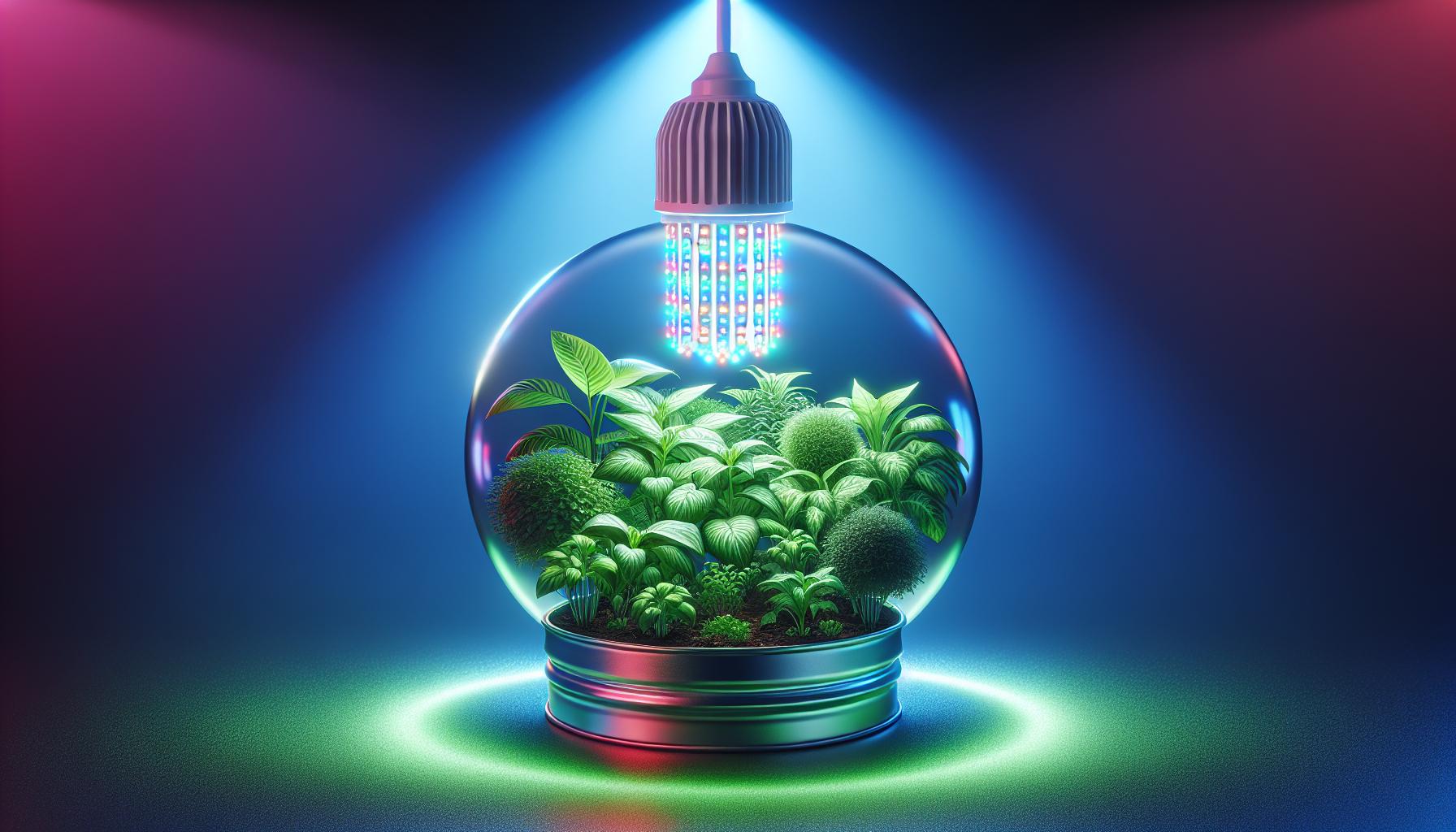
Grow lights are a marvel for indoor gardeners, transforming your living space into a plant paradise. Think of them as your plant’s personal sun, offering the spectrum of light most beneficial for growth. Plants are picky about their light; they thrive on a specific range of color temperatures, usually between 4000K and 6000K which represents cool to bright daylight.
The core spectrum for grow lights generally includes blue and red wavelengths. Blue light promotes lush leaf growth, while red light helps encourage flowering and fruiting. But here’s the cherry on top: full-spectrum grow lights include these and other wavelengths, making them the most versatile choice for various plant types.
Let’s get technical. There’s a bunch of bulb options, but the most common for everyday enthusiasts like you are fluorescents and LEDs:
- Fluorescents, such as T5 or compact fluorescents, are energy-efficient and provide decent coverage for a modest indoor garden.
- LED grow lights boast even greater energy efficiency and longer lifespans. They generate less heat and can be ideal if you’re looking to keep things cool.
When considering your regular lamp as a vessel for grow lights, take a minute to appreciate the specs. You’ll want to match the socket type – typically E26 or E27 screw bases in the US – with the grow light bulb you choose. Also, check the voltage compatibility to prevent any mishaps.
« Why Is My Light Bulb Not Working? Fix It With These Simple Tips
Can You Put LED Light Bulbs in Any Fixture? Avoid These Common Mistakes »
During your DIY home projects, you might wonder about intensity. Candela, lumens, and watts are terms thrown around, but what you should focus on is the PPFD – Photosynthetic Photon Flux Density. In layman’s terms, it measures the light that actually reaches your plant, which is the ultimate goal.
Types of Grow Light Bulbs
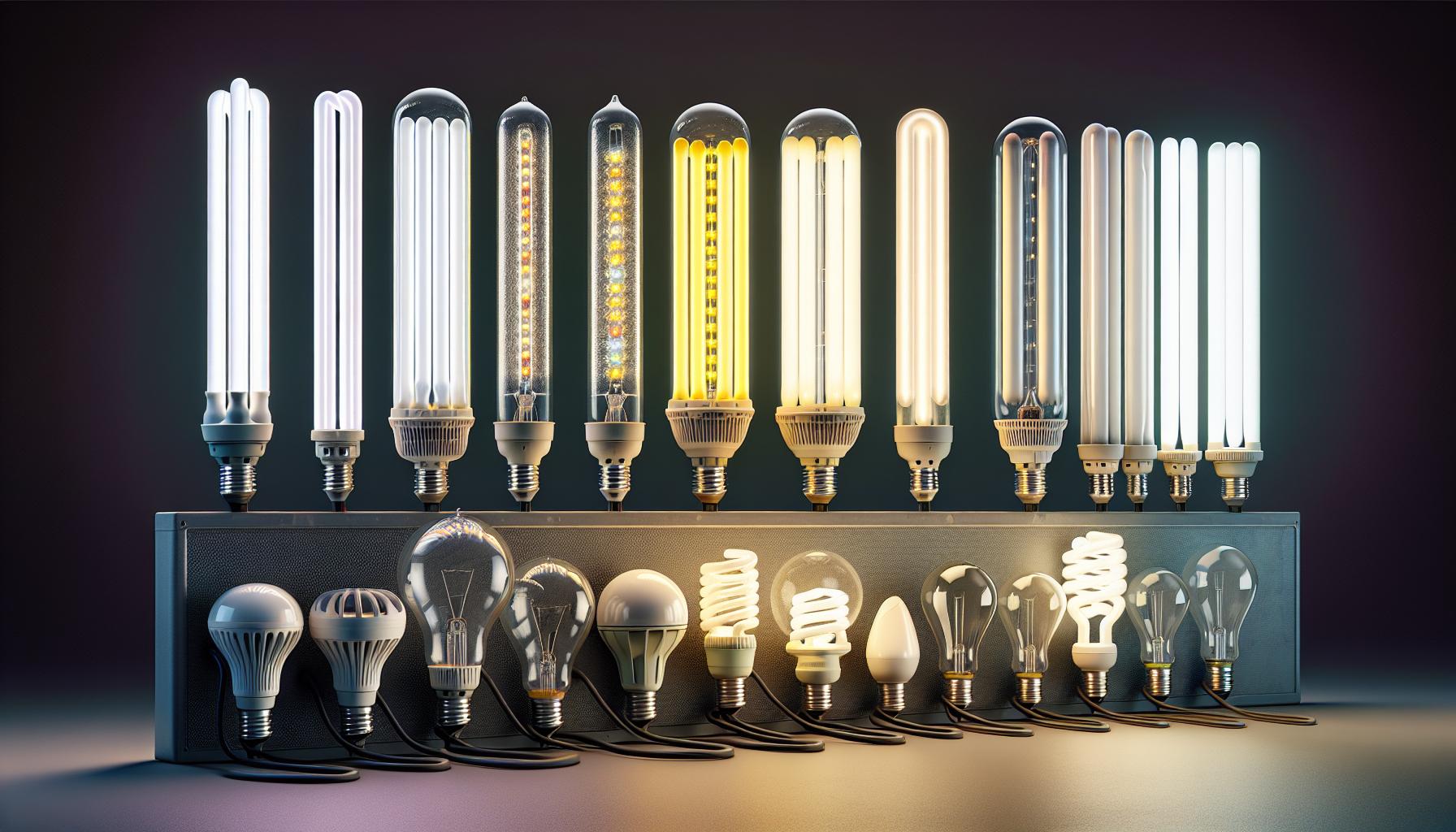
When you’re looking to convert your standard lamp into a beacon for plant growth, you’ll find a variety of grow light bulbs at your disposal. Each type has its unique advantages depending on the plants you’re nurturing and the size of your indoor garden.
Incandescent Grow Lights are akin to the traditional light bulbs you’re probably most familiar with. However, these bulbs aren’t your top choice for a mini greenhouse because they emit more heat than light, raising the risk of harming your plants if placed too close.
Next, you’ve got Fluorescent Grow Lights. These are the go-to for many indoor gardeners due to their energy efficiency and lower heat production. They come in two main types:
- T5 Bulbs: Ideally suited for small, low-light plants and seedlings
- Compact Fluorescent Lights (CFLs): Great for spaces where more focused light is needed
LED Grow Lights have surged in popularity and for good reason. They’re energy-savers and emit the least amount of heat, which makes them perfect for a variety of plants. Moreover, they often come with customizable spectrums, which allow you to tweak the light’s color balance to encourage different stages of plant growth.
Another contender is the High-Intensity Discharge (HID) Grow Lights. They’ve been around for a while and are particularly effective for larger indoor gardens. These lights are incredibly bright and come in two main types:
- Metal Halide (MH) Bulbs: Foster growth by providing a light that’s close to natural daylight
- High-Pressure Sodium (HPS) Bulbs: They promote flowering and fruiting due to their warmer light spectrum
Remember, too much intensity can lead to light burn, so it’s crucial to position HID bulbs at an appropriate distance from your plants.
The rise of Ceramic Metal Halide (CMH) and Light Emitting Ceramic (LEC) bulbs is noteworthy. They offer a fuller spectrum and are more energy-efficient than traditional HIDs, making them a solid middle-ground choice.
Choosing the Right Grow Light Bulb

When you’re passionate about your indoor garden, selecting the right grow light bulb is crucial to achieving the lush growth you’re aiming for. You’ll want to account for the specific needs of your plants while also considering the practicality of the light bulbs you place in your regular lamp fixtures.
Light Output and Spectrum are key factors in plant growth. You’re looking for bulbs that emit a spectrum close to natural sunlight. LEDs and fluorescents are your friends here – they offer a range of color temperatures conducive to different growth stages, with blue spectrum for vegetative growth and red spectrum for flowering.
Intensity is another consideration. Your seedlings and small plants won’t need the same intense light that your mature plants crave. Match the lumens to the size and stage of your plant. Remember, too much light can lead to light burn, while too little can result in weak, leggy plants.
- LED grow lights provide high intensity with lower energy consumption.
- Fluorescents, such as T5 and CFLs, are gentle and ideal for smaller plants.
Energy Efficiency affects not only your plants but also your electricity bill. LED grow lights are at the top of the energy-saving hierarchy, followed by fluorescents. Incandescent bulbs, while an option, are less energy-efficient and run hotter – not ideal if you’re trying to keep things cool.
Compatibility with your household lamps is vital. You’ll need to confirm that the bulb base matches your lamp fixture. Most grow light bulbs are designed to fit standard sockets, but it’s always best to check before making a purchase.
Heat Generation is the last piece of the puzzle. LEDs and fluorescents tend to run cool, making them safe for close proximity to plants. HIDs, though ideal for larger setups, produce a lot of heat and might require additional cooling systems.
Armed with this knowledge and your DIY spirit, you’re well on your way to transforming those everyday lamps into beacons of growth for your indoor greenery. Make the swap, tract the progress, and watch your indoor garden thrive under the glow of the right grow lights.
Considerations for Using Grow Light Bulbs in Regular Lamps

When you’re keen on giving your indoor garden just what it needs, you might wonder if your standard lamp can double as a plant’s best friend with the right bulb. Sure, popping a grow light bulb into a regular lamp is possible, but there are important factors to weigh in before you do.
Firstly, check the fixture’s maximum wattage. Grow light bulbs often demand more power, and your regular lamp might not be cut out for that kind of intensity. If you push the limits, you can end up frying your lamp, or even worse, creating a fire hazard.
Next, scrutinize the lamp’s design. Grow light bulbs are built to distribute light in a way that mimics the sun. Your regular lamp, however, may not have the necessary refraction and reflection properties to spread that light evenly to your plants. Also, consider the distance between the lamp and your plants. Too far and your greens won’t get enough light; too close and you risk scorching their delicate leaves.
Energy efficiency is another crucial piece. Are the bulbs compatible with your lamp’s voltage and does the lamp allow for the useful features of the grow bulb, like being able to turn on or off at set times? LED grow light bulbs outshine others in efficiency, but your regular lamp might not fully capitalize on these perks without the appropriate setup.
Regarding heat generation, LED bulbs are your best bet as they don’t get as hot as other types. However, if you opt for higher-intensity bulbs such as HIDs or some fluorescents, make sure your lamp can handle the excess heat generated without damage to its parts or the surrounding area.
So before you make the switch, ensure that you’ve considered these aspects:
- Wattage compatibility
- Lamp design suitability
- Proper distance for light distribution
- Energy efficiency and special features
- Heat tolerance of the lamp
With a bit of know-how and the right setup, you can transform your regular lamp into an effective source of life for your plants. Keep in mind that light is just one piece of the puzzle in your journey to create an indoor Eden—so keep exploring and tinkering to give your green buddies the best you’ve got. Now, isn’t that an illuminating thought?
Conclusion
So there you have it! You’re now equipped with the know-how to give your indoor garden a boost by using grow light bulbs in your regular lamps. Just remember to double-check your lamp’s specs, keep an eye on the placement, and make sure everything’s in sync for your leafy friends to thrive. Happy gardening!
Frequently Asked Questions
Can I use grow light bulbs in regular lamps for indoor gardening?
Yes, you can use grow light bulbs in regular lamps for indoor gardening, but ensure the lamp can handle the bulb’s wattage, compatibility, and heat emission properly.
What should I check before placing a grow light bulb in a regular lamp?
Before using a grow light bulb in a regular lamp, check the lamp’s maximum wattage, ensure it allows for proper light distribution, and consider the distance between the lamp and your plants.
Is it important to consider energy efficiency when selecting grow light bulbs for regular lamps?
Yes, energy efficiency is important when selecting grow light bulbs for regular lamps to ensure lower electricity bills and reduce environmental impact.
How do I know if my regular lamp can tolerate the heat from a grow light bulb?
To determine if your regular lamp can tolerate the heat, review the lamp’s material and construction. Lamps with metal parts and adequate ventilation are generally more heat-tolerant.

